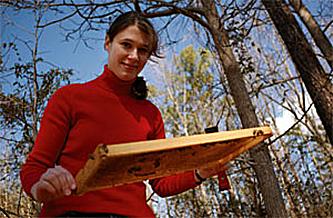Dr. Christina Grozinger
NCSU Website
Susan Cobey
Susan Cobey's Website
|
|
|---|
|
Dr. Christina Grozinger NCSU Website Susan Cobey Susan Cobey's Website |
Review of "Instrumental Insemination of Honeybee Queens with Susan Cobey" Instructional DVD |
|---|
 By Dr. Christina Grozinger... Insect Genomics, Departments of Entomology and Genetics,
North Carolina State University. (Now at Penn State College of Agricultural Sciences)
By Dr. Christina Grozinger... Insect Genomics, Departments of Entomology and Genetics,
North Carolina State University. (Now at Penn State College of Agricultural Sciences)
Instrumental insemination of honey bees is becoming an increasingly important tool for producing healthy colonies. Since it is impossible to control the natural mating behavior of queens, instrumental insemination is the only available method to ensure that queens are crossed with specific drones, or even to make sure that queens have mated with a large number of drones. The recent emergence of "Colony Collapse Disorder" has highlighted to need for developing robust stocks of bees, which have strong, healthy colonies that are gentle, resistant to pests and diseases, and well-adapted to particular climate conditions. In areas were Africanized bees are established, instrumental insemination is critical for preventing matings with Africanized drones. Furthermore, recent studies have demonstrated that well-mated queens are important for maintaining colony health: colonies headed by multiply inseminated queens are more successful (Mattila and Seeley 2007), and multiply inseminated queens produce more potent pheromones (Richard et al. 2007). Thus, controlling queen mating by using instrumental insemination is a valuable option, for researchers, breeders, and hobby beekeepers. However, collecting semen and inseminating queens is a tricky procedure, and not something that can be easily learned by simply reading a book.
Sue Cobey's recently updated DVD, "Instrumental Insemination of Honeybee
Queens" provides a valuable resource for amateurs learning this technique, or to
experienced beekeepers interested in brushing up before queen rearing season. Sue is
an internationally acclaimed expert in instrumental insemination. She has played an
integral part in several research programs, first at the Rothenbuhler Honey Bee
Research Laboratory at Ohio State University, and more recently at the Harry H.
Laidlaw Jr. Honey Bee Biology Research Facility at University of California, Davis,
publishing peer-reviewed scientific studies involving inseminated queens (e.g. Cobey,
2007). Sue has single-handedly developed and maintained a closed breeding program
to produce the New World Carniolan stock of bees for 30 years, and has taught aspiring
beekeepers and researchers queen rearing and insemination in an annual series of
courses ("The Art of Queen Rearing," "Instrumental Insemination and
Bee Breeding" and "Advanced Instruction Instrumental Insemination.")
for the last 25 years. Sue's expertise and dedication in training students in the
art of instrumental insemination clearly shines through in this expertly produced
DVD,
 which recently received the Gold Medal at the 2007 International Apimondia Conference
in Melbourne, Australia. The DVD includes detailed information about all the key
areas in this procedure, from rearing healthy queens and drones, different
instrumentation options, "popping" drones to collect the semen, storing
semen, positioning the queen for proper insemination, and introducing newly
inseminated queens to colonies. The important of sterile technique is emphasized,
and studies related to factors that may reduce queen performance are discussed.
Finally, several references related to queen insemination and breeding are included
for those who want further information.
which recently received the Gold Medal at the 2007 International Apimondia Conference
in Melbourne, Australia. The DVD includes detailed information about all the key
areas in this procedure, from rearing healthy queens and drones, different
instrumentation options, "popping" drones to collect the semen, storing
semen, positioning the queen for proper insemination, and introducing newly
inseminated queens to colonies. The important of sterile technique is emphasized,
and studies related to factors that may reduce queen performance are discussed.
Finally, several references related to queen insemination and breeding are included
for those who want further information.
The only drawback to this video is that Sue makes instrumental insemination look so easy that beginners might suffer a blow to their ego! This is a challenging technique that requires a great deal of practice and patience, regardless of the fact that the DVD is extremely informative and clear. For those novices interested in speeding up the learning process, Sue offers hands-on instrumental insemination courses. However, for both beginners and experts, this DVD is an important resource and is highly recommended. Information on the DVD, courses, and equipment can be obtained from Susan Cobey's website via the button on top left. (Please note: The video has been updated since this review was written, although I understand the main content is still the same. Roger Patterson.)
References
Cobey SW (2007) Comparison studies of instrumentally inseminated and naturally mated
honey bee queens and factors affecting their performance. Apidologie 38: 390-410.
Mattila HR, Seeley TD (2007) Genetic diversity in honey bee colonies enhances
productivity and fitness. Science 317(5836): 362-364.
Richard FJ, Tarpy DR, Grozinger CM (2007) Effects of insemination quantity on honey
bee queen physiology. PLoS ONE 2(10): e980.
Printed from Dave Cushman's website Live CD version
|
|